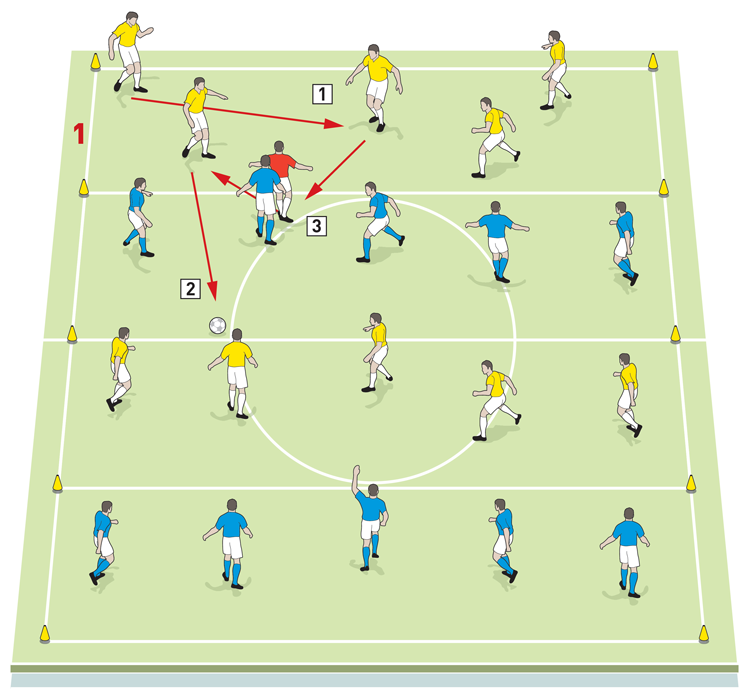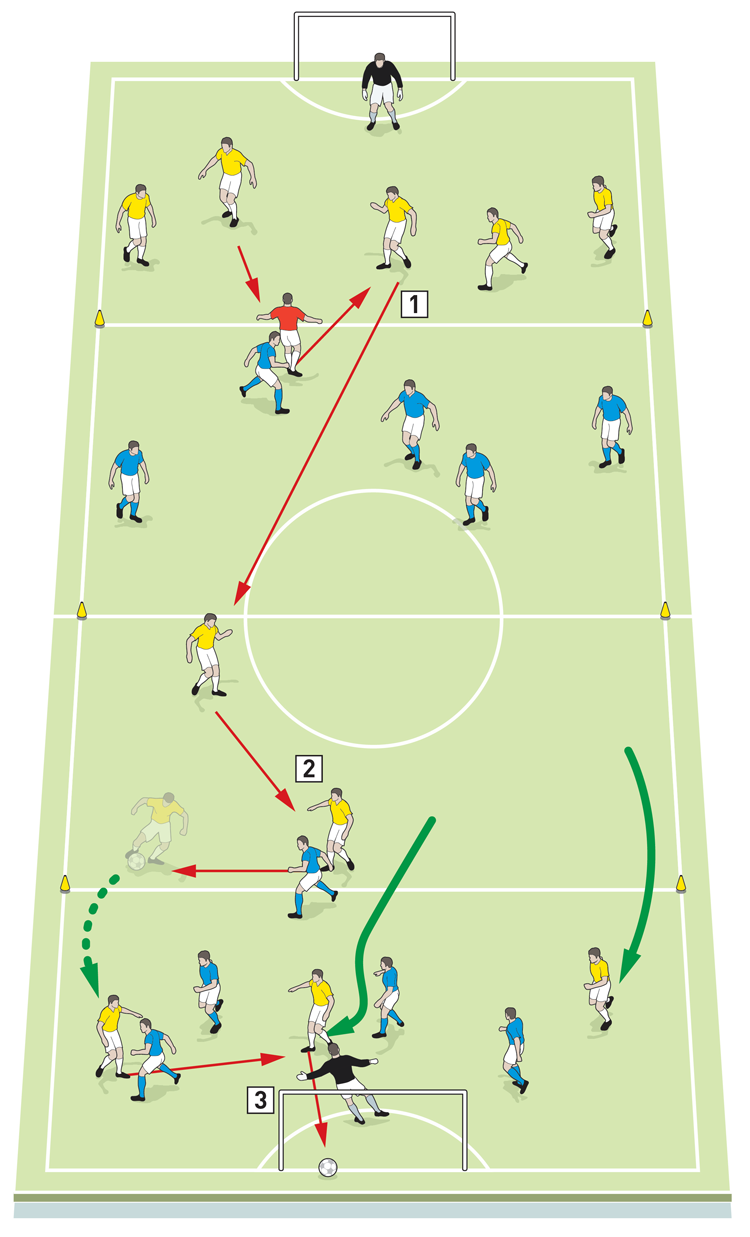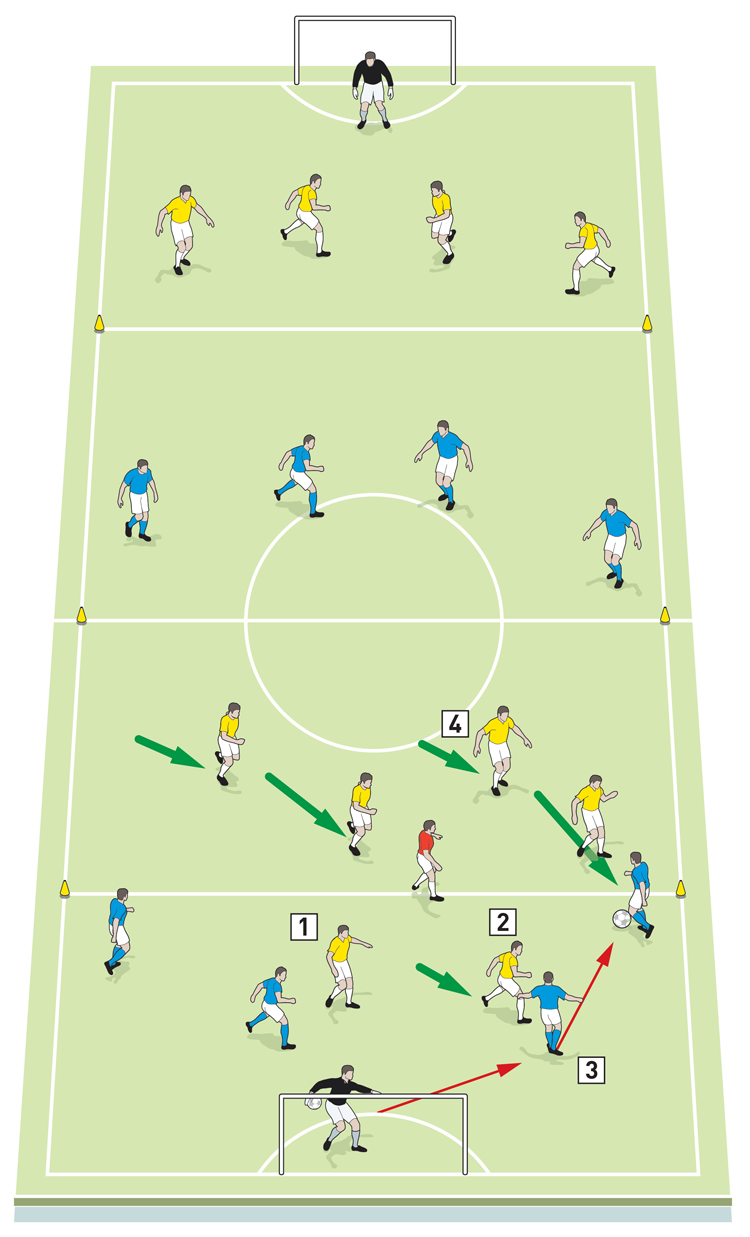The aim of this session is to prevent the opposition from playing through your team’s midfield and then to regain the ball by controlling where opponents play.

| Area | Use of a full pitch |
| Equipment | Balls, cones, goals |
| No. of Players | Up to a full squad |
| Session Time | 40x40-yard practice 10mins (incl. stoppages/rotations), 40x80-yard practice 10mins (and progression 15mins), 3x5min games |
This session allows the coach to help implement player roles when a team is out of possession. It also allows for the units to be connected (midfielders and forwards) and for them to make match-relevant decisions.
Ultimately, the aim is to prevent the opposition from playing through our midfield and, from there onwards, the intention is to regain the ball by controlling where opponents play.
It builds from an extension of the warm-up, gradually introducing progressions to become closer to game situations and the decision-making within that. The session allows me to coach our fundamental principles when we are out of possession – in particular, the roles of the strikers and midfielders – with further opportunity for the defenders to become stretched and defend an attacking overload.
This session is best structured as a bringing together of previous ‘out of possession’ training sessions or analysis – for instance, during pre-season after coaching how units defend. It then allows the team to defend together and make decisions based on what players are doing in front of them.
It is beneficial to repeat this session regularly, particularly because it can be altered depending on the shape we play, e.g. 4-3-3, 4-4-2, or perhaps when assessing the strength of upcoming opponents.
40x40-yard practice
What do I get the players to do?
Setting up as shown (1), this is a 23-man practice (including keepers) that is comprised of four zones of 10 yards each. For the purpose of this session it will build into defending principles in a 4-4-2 formation.
1

2. A gap appears and they thread the ball through the blue
3. The neutral red plays for the team in possession
In the first instance, end yellows move the ball two-touch looking for opportunities to play through the line of blue midfielders, with the ball being kept below head height at all times. Upon winning possession blues then look to play through central yellows, with the red floater always supporting the team in possession in the two central zones. The intention here is for the player to help break the midfield line, though he can be pressed and tackled by screening midfielders.
We will ensure we rotate players in central areas regularly in order to keep the challenge fresh.
What are the key things to look out for?
We want players to slide and screen as the ball moves sideways, with no gaps in between. We want the nearest player to press the ball then quickly retreat to a covering position when a pass is played across. Within this we want to see pace, intensity and a desire to prevent a forward pass, with players communicating with and encouraging each other.
40x80-yard practice
Now we add in two central 10-yard zones and introduce keepers by extending the end zones (2). If a team is successful playing through the midfield screen they can then attack 5v5 in looking to score.
2

1. Yellows have successfully threaded a pass through the blue bank of players
2. Offensive yellows now receive and move forward to attack blues in a 5v5
3. Yellows combine well and a goal is scored
What are the key things to look out for?
As before, the focus here is on coaching both individual and back four defending principles, but also with the introduction of centre-forwards in a defending role. These centre-forwards must look to screen and defend the red floater (who represents a team’s deep centre-midfielder). Ideally, we are looking for opportunities where one centre-forward screens while the other looks to keep play down one side. This allows the midfield screen to slide across, cutting off all passing channels. It is important to try to deny a switch of play.
How do I progress the practice?
As a progression, if an opposing team likes to play with two deep centre-midfielders then another of the midfield blues (as referenced in previous diagrams) can drop in to play in the same area as the red, as shown (3). This gives the opportunity to practise how your team deals with this situation – for instance perhaps by releasing a midfielder to press, or maybe by dropping both centre-forwards back to screen. In this instance, one is more aggressive than the other, but it is good to be able to apply both options depending on the game situation that your team finds itself in.
3

1. One centre-forward screens
2. The other ensures play stays down one side of the pitch
3. Blues are now forced to attack in limited space
4. This limited space is also protected by the midfield screen which moves across
What are the key things to look out for?
For defenders, we’re looking for individual defending, 1v1s (and taking control of them), players showing opponents away from goal, the blocking of shots, and playing with weight forward. We also want to see good use of body, back four defending, smart cover positioning, good communication and an eye on who can deal with the greatest danger.
For midfielders, we want to see a blocking screen, with players sliding, pressing and covering. There must be front-foot interceptions in breaking and countering on the regain. There is a three-second time limit on recovering back into shape, and the ball must be kept in front of the player.
For centre-forwards, it’s a case of dealing with deep centre-midfielders, with a condition to stop the switches of play in order to help team mates in behind. We also want to see availability on regains.
This session is designed to extend and over-exaggerate aspects of team defending. Therefore, it is important to finish with a game situation to test the team’s understanding.
How do I put this into a game situation?
For this game situation we take out the middle line and use the thirds as offside lines, whilst retaining the width as the penalty box, as shown (4).
4

It’s important that on any restart the defending team has three seconds to recover back into a defensive shape. They must do this to keep the ball in front of them whilst practising all previous observations. The match provides us, as coaches, with the ultimate ability to assess player understanding based on each of the units, roles and responsibilities (for defenders, midfielders and centre-forwards).
Editor's Picks
Attacking transitions
Deep runs in the final third
Using the goalkeeper in build-up play
Intensive boxes drill with goals
Penetrating the final third
Creating and finishing
My philosophy
Pressing initiation
Compact team movement
Coaches' Testimonials

Alan Pardew

Arsène Wenger

Brendan Rodgers

Carlos Carvalhal

José Mourinho

Jürgen Klopp

Pep Guardiola

Roy Hodgson

Sir Alex Ferguson

Steven Gerrard
Coaches' Testimonials

Gerald Kearney, Downtown Las Vegas Soccer Club

Paul Butler, Florida, USA

Rick Shields, Springboro, USA

Tony Green, Pierrefonds Titans, Quebec, Canada
Join the world's leading coaches and managers and discover for yourself one of the best kept secrets in coaching. No other training tool on the planet is written or read by the calibre of names you’ll find in Elite Soccer.
In a recent survey 92% of subscribers said Elite Soccer makes them more confident, 89% said it makes them a more effective coach and 91% said it makes them more inspired.
Get Monthly Inspiration
All the latest techniques and approaches
Since 2010 Elite Soccer has given subscribers exclusive insight into the training ground practices of the world’s best coaches. Published in partnership with the League Managers Association we have unparalleled access to the leading lights in the English leagues, as well as a host of international managers.
Elite Soccer exclusively features sessions written by the coaches themselves. There are no observed sessions and no sessions “in the style of”, just first-hand advice delivered direct to you from the coach.








